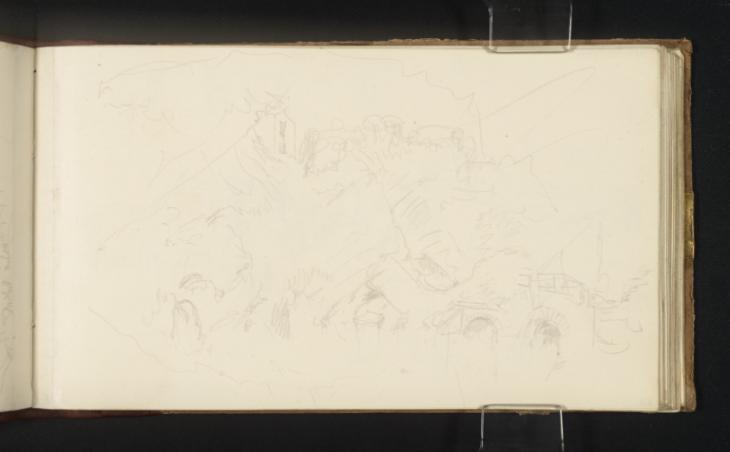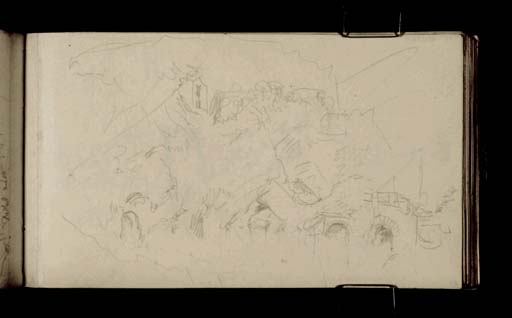J.M.W. Turner
>
1830-35 Annual tourist
>
Midlands 1830
>
Kenilworth Sketchbook
>
Artwork
Joseph Mallord William Turner Tunnels at Castle Mill Basin on the Dudley Canal, from the Mouth of a Limestone Mine 1830
Image 1 of 2
Joseph Mallord William Turner,
Tunnels at Castle Mill Basin on the Dudley Canal, from the Mouth of a Limestone Mine
1830
Joseph Mallord William Turner 1775–1851
Folio 61 Verso:
Tunnels at Castle Mill Basin on the Dudley Canal, from the Mouth of a Limestone Mine 1830
D22090
Turner Bequest CCXXXVIII 59a
Turner Bequest CCXXXVIII 59a
Pencil on white wove paper, 120 x 203 mm
Partial watermark ‘nard | 20’
Partial watermark ‘nard | 20’
Accepted by the nation as part of the Turner Bequest 1856
References
1909
A.J. Finberg, A Complete Inventory of the Drawings of the Turner Bequest, London 1909, vol.II, p.731, CCXXXVIII 59a, as ‘Do. do. do.’ (i.e. ditto: ‘Tamworth, or near Tamworth (? Dudley)’).
1990
Frank Milner, J.M.W. Turner: Paintings in Merseyside Collections: Walker Art Gallery; Sudley Art Gallery; Williamson Art Gallery; Lady Lever Art Gallery; Liverpool University Art Gallery, Liverpool 1990, p.53 under no.26, as a Dudley subject.
Finberg was unsure whether this drawing, inverted relative to the sketchbook’s foliation, showed Tamworth (see under folio 52 verso; D22072; Turner Bequest CCXXXVIII 51c) or Dudley.1 Derek Gittings, of the Dudley Canal and Tunnel Trust, has identified the scene as Castle Mill Basin, east of Forest Road at the north end of Castle Hill, not far from the Black Country Living Museum: ‘The basin is part of the Dudley Canal tunnel which takes the Dudley No.1 Canal under the town of Dudley and also served as the hub for a system of underground canals.’2
The loose surrounding marks show the viewpoint as a rocky opening; compare the similar treatment of a view from a cave out to the beach at Tintagel in the 1811 Cornwall and Devon sketchbook (Tate D41338; Turner Bequest CXXV a 57). Mr Gittings has observed: ‘Castle Mill Basin [has] a large triangular mine entrance overlooking it, giving a view of the tunnel entrances. This entrance was visible until a few years ago before it was covered by concrete stabilisation work by Dudley Council.’ He continues: ‘There are a number of descriptions, paintings, sketches and engravings of the Castle Mill Basin, mainly from the early-mid nineteenth century. It appears that it was a popular site for artists and travel writers and many of the views are from the mine entrance’.3
In particular, Mr Gittings has noted a work by the Birmingham watercolourist Joseph Barber (1757–1811), acquired by Dudley Art Gallery (now part of Dudley Archives) with a contribution from the Canal Trust. Barber’s more developed composition is similarly framed by the natural proscenium arch of the mine entrance, with a small figure manoeuvring a boat beyond; it was evidently drawn from a few steps to the right, with the walkway over the tunnel entrance on the right here brought into the foreground, and the same house shown among the trees above.
The semi-subterranean setting faintly recalls paintings by another Midlands artist, Joseph Wright of Derby (1734–1797), looking out from a grotto on the Gulf of Salerno (versions: Derby Museum and Art Gallery; Yale Center for British Art, New Haven). The mundane Dudley basin was evoked in full-blown Romantic mode in an 1825 account of Dudley Castle and its surroundings by a local author and antiquarian, the Reverend Luke Booker:
[s]uddenly look down on what Fancy may deem a Stygian Pool, with wherries there waiting to transport disembodied spirits to their eternal destination. Deeply-sunken amid rocks and caves, the sunbeam seldom warms its sullen waters; and the pallid beings, who occasionally are seen propelling boats into apertures of invisible passages, clad in their barracan [heavy woollen] mine-dresses, camelion-like appear to derive their hue from the rocks which surround them.4
Booker continued:
Those rocks, reflected on the surface of the aqueous mirror, afford a vast imaginary depth to the Pool. Rising perpendicularly, their rugged fantastic shapes, apparently visible through a supposed pellucid medium, seem, by inversion to lead the eye to their very base.– This singular spot is called The Basin; whence diverge four subterranean Canals; one, for commercial purposes, nearly two miles in length; and three, formed on the same water-level, for conveyance of the lime-stone, torn, by explosion with gun-powder, from the bowels of the earth, under the neighbouring hills.1
Turner’s swift outline sketch is necessarily more prosaic, though he clearly found potential in the setting. The area was indeed subject to intensive limestone mining and quarrying for building stone and lime used in mortar and fertiliser and in the blast furnaces of the local iron industry, extracted from Castle Hill and the nearby Wren’s Nest,2 which is the viewpoint for the drawings on folios 59 recto and verso and 60 recto (D22085, D22086, D22087; Turner Bequest CCXXXVIII 57, 57a, 58).
Matthew Imms
August 2013
See ‘Wren’s Nest National Nature Reserve’, Dudley Metropolitan Borough Council, accessed 11 July 2013, http://www.dudley.gov.uk/resident/environment/countryside/nature-reserves/wrens-nest-nnrwrens-nest-nnr/ ; and ‘The Geology of Wren’s Nest Nature Reserve’, BGCS: The Black Country Geological Society, accessed 11 July 2013, http://www.bcgs.info/pdf_files/wrens_nest_leaflet_2009.pdf .
Revised November 2019
How to cite
Matthew Imms, ‘Tunnels at Castle Mill Basin on the Dudley Canal, from the Mouth of a Limestone Mine 1830 by Joseph Mallord William Turner’, catalogue entry, August 2013, in David Blayney Brown (ed.), J.M.W. Turner: Sketchbooks, Drawings and Watercolours, Tate Research Publication, September 2014, https://www


